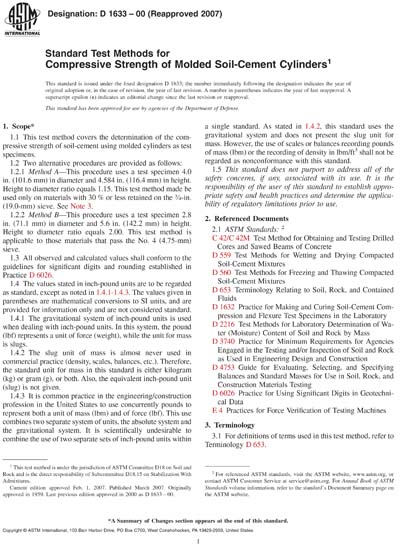Historical
ASTM D1633-00(2007)
Standard Test Methods for Compressive Strength of Molded Soil-Cement Cylinders
1.1 This test method covers the determination of the compressive strength of soil-cement using molded cylinders as test specimens.
1.2 Two alternative procedures are provided as follows:
1.2.1 Method A - This procedure uses a test specimen 4.0 in. (101.6 mm) in diameter and 4.584 in. (116.4 mm) in height. Height to diameter ratio equals 1.15. This test method made be used only on materials with 30 % or less retained on the 3/4-in. (19.0-mm) sieve. See Note 3.
1.2.2 Method B - This procedure uses a test specimen 2.8 in. (71.1 mm) in diameter and 5.6 in. (142.2 mm) in height. Height to diameter ratio equals 2.00. This test method is applicable to those materials that pass the No. 4 (4.75-mm) sieve.
1.3 All observed and calculated values shall conform to the guidelines for significant digits and rounding established in Practice D 6026.
1.4 The values stated in inch-pound units are to be regarded as standard, except as noted in 1.4.1-1.4.3. The values given in parentheses are mathematical conversions to SI units, and are provided for information only and are not considered standard.
1.4.1 The gravitational system of inch-pound units is used when dealing with inch-pound units. In this system, the pound (lbf) represents a unit of force (weight), while the unit for mass is slugs.
1.4.2 The slug unit of mass is almost never used in commercial practice (density, scales, balances, etc.). Therefore, the standard unit for mass in this standard is either kilogram (kg) or gram (g), or both. Also, the equivalent inch-pound unit (slug) is not given.
1.4.3 It is common practice in the engineering/construction profession in the United States to use concurrently pounds to represent both a unit of mass (lbm) and of force (lbf). This use combines two separate system of units, the absolute system and the gravitational system. It is scientifically undesirable to combine the use of two separate sets of inch-pound units within a single standard. As stated in 1.4.2, this standard uses the gravitational system and does not present the slug unit for mass. However, the use of scales or balances recording pounds of mass (lbm) or the recording of density in lbm/ft3 shall not be regarded as nonconformance with this standard.
This standard does not purport to address all of the safety concerns, if any, associated with its use. It is the responsibility of the user of this standard to establish appropriate safety and health practices and determine the applicability of regulatory limitations prior to use.
ASTM International [astm]

